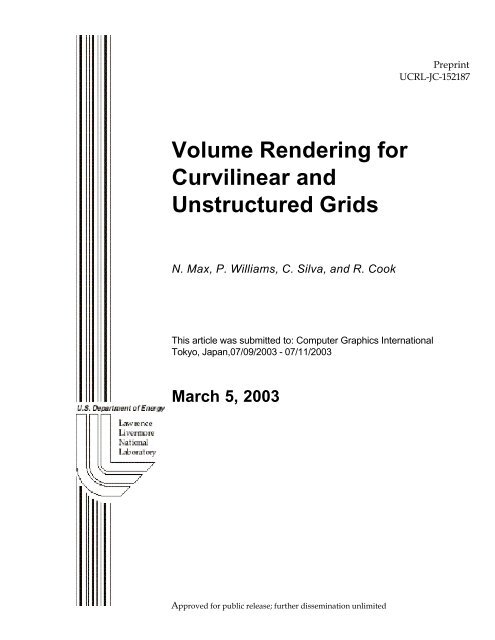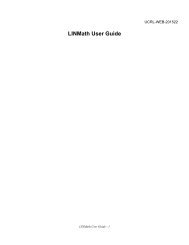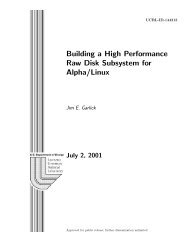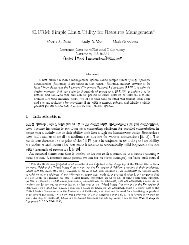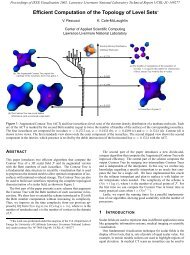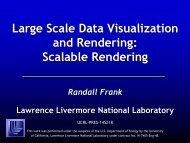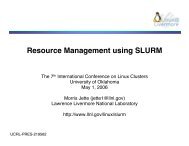Volume Rendering for Curvilinear and Unstructured Grids
Volume Rendering for Curvilinear and Unstructured Grids
Volume Rendering for Curvilinear and Unstructured Grids
You also want an ePaper? Increase the reach of your titles
YUMPU automatically turns print PDFs into web optimized ePapers that Google loves.
Preprint<br />
UCRL-JC-152187<br />
<strong>Volume</strong> <strong>Rendering</strong> <strong>for</strong><br />
<strong>Curvilinear</strong> <strong>and</strong><br />
<strong>Unstructured</strong> <strong>Grids</strong><br />
N. Max, P. Williams, C. Silva, <strong>and</strong> R. Cook<br />
This article was submitted to: Computer Graphics International<br />
Tokyo, Japan,07/09/2003 - 07/11/2003<br />
March 5, 2003<br />
Approved <strong>for</strong> public release; further dissemination unlimited
DISCLAIMER<br />
This document was prepared as an account of work sponsored by an agency of the United States<br />
Government. Neither the United States Government nor the University of Cali<strong>for</strong>nia nor any of their<br />
employees, makes any warranty, express or implied, or assumes any legal liability or responsibility <strong>for</strong> the<br />
accuracy, completeness, or usefulness of any in<strong>for</strong>mation, apparatus, product, or process disclosed, or<br />
represents that its use would not infringe privately owned rights. Reference herein to any specific<br />
commercial product, process, or service by trade name, trademark, manufacturer, or otherwise, does not<br />
necessarily constitute or imply its endorsement, recommendation, or favoring by the United States<br />
Government or the University of Cali<strong>for</strong>nia. The views <strong>and</strong> opinions of authors expressed herein do not<br />
necessarily state or reflect those of the United States Government or the University of Cali<strong>for</strong>nia, <strong>and</strong> shall<br />
not be used <strong>for</strong> advertising or product endorsement purposes.<br />
This is a preprint of a paper intended <strong>for</strong> publication in a journal or proceedings. Since changes may be<br />
made be<strong>for</strong>e publication, this preprint is made available with the underst<strong>and</strong>ing that it will not be cited or<br />
reproduced without the permission of the author.<br />
This report has been reproduced directly from the best available copy.<br />
Available electronically at http://www.doc.gov/bridge<br />
Available <strong>for</strong> a processing fee to U.S. Department of Energy<br />
And its contractors in paper from<br />
U.S. Department of Energy<br />
Office of Scientific <strong>and</strong> Technical In<strong>for</strong>mation<br />
P.O. Box 62<br />
Oak Ridge, TN 37831-0062<br />
Telephone: (865) 576-8401<br />
Facsimile: (865) 576-5728<br />
E-mail: reports@adonis.osti.gov<br />
Available <strong>for</strong> the sale to the public from<br />
U.S. Department of Commerce<br />
National Technical In<strong>for</strong>mation Service<br />
5285 Port Royal Road<br />
Springfield, VA 22161<br />
Telephone: (800) 553-6847<br />
Facsimile: (703) 605-6900<br />
E-mail: orders@ntis.fedworld.gov<br />
Online ordering: http://www.ntis.gov/ordering.htm<br />
OR<br />
Lawrence Livermore National Laboratory<br />
Technical In<strong>for</strong>mation Department’s Digital Library<br />
http://www.llnl.gov/tid/Library.html
<strong>Volume</strong> <strong>Rendering</strong> <strong>for</strong> <strong>Curvilinear</strong> <strong>and</strong> <strong>Unstructured</strong> <strong>Grids</strong><br />
Nelson Max, Peter Williams, Claudio Silva, <strong>and</strong> Richard Cook<br />
Lawrence Livermore National Laboratory<br />
{max2, plw, rcook}@llnl.gov, csilva@cse.ogi.edu<br />
Abstract<br />
We discuss two volume rendering methods developed<br />
at Lawrence Livermore National Laboratory. The first, cell<br />
projection, renders the polygons in the projection of each<br />
cell. It requires a global visibility sort in order to composite<br />
the cells in back to front order, <strong>and</strong> we discuss several<br />
different algorithms <strong>for</strong> this sort. The second method uses<br />
regularly spaced slice planes perpendicular to the X, Y, or<br />
Z axes, which slice the cells into polygons. Both methods<br />
are supplemented with anti-aliasing techniques to deal<br />
with small cells that might fall between pixel samples or<br />
slice planes, <strong>and</strong> both have been parallelized.<br />
1. Introduction<br />
In volume rendering <strong>for</strong> scientific visualization, a 3D<br />
scalar field is represented by a cloud of very small glowing<br />
particles, whose color <strong>and</strong> density depend on the scalar<br />
variable. The rendering then calculates how this cloud<br />
would appear in a given view (see [1]).<br />
If the scalar field is sampled on a cubical or rectilinear<br />
grid, graphics hardware can render the volume in real<br />
time, using texture mapping [2]. However, at Lawrence<br />
Livermore National Laboratory we need to render volumes<br />
from physics simulations on curvilinear grids, or on unstructured<br />
finite element grids with mixed element types,<br />
currently with the topology of tetrahedra, cubes, triangular<br />
prisms, <strong>and</strong> square pyramids. Over the past 13 years, we<br />
have worked on two methods <strong>for</strong> directly rendering the<br />
cells of such general grids, without resampling the data<br />
onto a rectilinear grid.<br />
The cell projection method divides the projection of<br />
each cell into polygons, <strong>and</strong> uses graphics hardware to<br />
draw them. This was first done <strong>for</strong> tetrahedra by Shirley<br />
<strong>and</strong> Tuchman [3]. Our extension to general polyhedra is<br />
described in section 2 below. In order <strong>for</strong> the hardware to<br />
composite these polygons correctly, the cell must sorted in<br />
back to front order, <strong>and</strong> section 3 describes several method<br />
<strong>for</strong> doing this. In our general grids, cells may have nonplanar<br />
quadrilateral faces, which may cause problems <strong>for</strong><br />
both the sorting <strong>and</strong> the polygon scan conversion. Section<br />
4 describes a solution which selectively subdivides such<br />
cells into tetrahedra, only <strong>for</strong> views where they would<br />
cause problems.<br />
The second method, described in section 5, involves<br />
slicing the cells into polygons by a collection of closely<br />
spaced parallel planes, as proposed by Yagel et al. [4], <strong>and</strong><br />
rendering these polygons. In section 6, we describe how<br />
we slice only those cells above a specific volume threshold,<br />
<strong>and</strong> render the others, which might lie between the<br />
slice planes or between pixel samples in these planes, using<br />
the anti-aliased ellipsoidal splats of Zwicker et al. [5].<br />
Large datasets require parallel processing <strong>for</strong> interactive<br />
visualization, <strong>and</strong> in section 7 we describe how we<br />
have parallelized parts of our two rendering methods.<br />
2. Polyhedron Projection<br />
The projections of the edges of a convex polyhedral<br />
cell divide the image plane up into polygons. Each of these<br />
polygons lies within the projection of a single front-facing<br />
face <strong>and</strong> a single back-facing face of the cell. There<strong>for</strong>e,<br />
<strong>for</strong> an orthogonal projection, the length l of the viewing<br />
ray segment within the cell varies linearly across the polygon,<br />
<strong>and</strong> can be interpolated linearly by the hardware.<br />
F<br />
D<br />
Figure 1. Projection of a triangular prism.<br />
E<br />
At the “thin” vertices A, B, C, D, <strong>and</strong> F in figure 1, the<br />
segment length, <strong>and</strong> there<strong>for</strong>e the compositing opacity, is<br />
zero, <strong>and</strong> the color is the one associated with the scalar<br />
value at the vertex. At the thick vertices, the length of the<br />
ray segment must be calculated geometrically, by finding<br />
the segment endpoints on the front <strong>and</strong> back faces which<br />
project to the vertex. We assume initially that the scalar<br />
field varies linearly across the cell, <strong>and</strong> that the transfer<br />
G<br />
C<br />
A<br />
B
functions that specify the particle color <strong>and</strong> density as a<br />
function of the scaler value are also linear. (See Max et al.<br />
[6] <strong>for</strong> a discussion of these assumptions.) Then the color<br />
at the ray segment endpoints can be obtained by interpolation<br />
across polygons (<strong>for</strong> the rear endpoint at E) or edges<br />
(<strong>for</strong> the endpoints of G). The densities κ <strong>for</strong> the cloud particles<br />
can similarly be interpolated. If κ avg is average of κ<br />
at the segment endpoints, the opacity α <strong>for</strong> compositing<br />
the segment is<br />
α(τ, l) = 1. - exp( -κ avg l) (1)<br />
as explained in [1]. Shirley <strong>and</strong> Tuchman [3] took the color<br />
<strong>for</strong> the thick vertex as the average of the colors at the<br />
segment endpoints. We have optionally used an analytic<br />
integration <strong>for</strong>mula, derived in [7] <strong>and</strong> [8], which takes<br />
longer but more accurately accounts <strong>for</strong> the fact that the<br />
particles at the front of the segment partially occlude those<br />
at the rear. The color is then linearly interpolated across<br />
the polygon by the Gouraud shading hardware. This is<br />
only an approximation, but the results look good.<br />
Shirley <strong>and</strong> Tuchman [3] also linearly interpolate the<br />
compositing opacity α across the polygons in hardware.<br />
This is a more serious approximation, because of the nonlinear<br />
exponential in equation (1). As shown in figure 2, it<br />
can cause derivative discontinuities in α, which result in<br />
disturbing Mach b<strong>and</strong>s in the image.<br />
Figure 2. Top: cross section <strong>for</strong> a scan plane through<br />
two adjacent cubes. Middle: two curves linearly interpolating<br />
the α values <strong>for</strong> the two cubes. Bottom: the<br />
results of compositing these two curves.<br />
To avoid this problem, we use a 2D texture table <strong>for</strong><br />
alpha. The two texture coordinates are κ avg <strong>and</strong> l, which<br />
do vary linearly across the polygons, <strong>and</strong> there<strong>for</strong>e can be<br />
correctly interpolated in the hardware. The texture is loaded<br />
with the values from equation (1), <strong>and</strong> then returns the<br />
correct exponential per pixel during rendering.<br />
Shirley <strong>and</strong> Tuchman [3] calculated the topology <strong>for</strong><br />
the projection of a tetrahedron into from one to four triangles<br />
using a collection of dot <strong>and</strong> cross products involving<br />
the vertices <strong>and</strong> the viewpoints to distinguish the different<br />
cases. Recently, these computations have been accomplished<br />
in hardware, using an advanced programable vertex<br />
“shader” engine [9].<br />
For more general cells, we us an incremental method<br />
to build the image plane subdivision. The projected edges<br />
of the cell are added one by one to the subdivision, starting<br />
with one infinite region with no boundary. An edge may<br />
create a new boundary cycle (as the first one does), create<br />
a new polygon by closing a cycle, or subdivide existing<br />
polygons <strong>and</strong> edges by slicing across them.<br />
This incremental method is slow, <strong>and</strong> not completely<br />
robust, since it uses floating point computations to determine<br />
the topology of the projection. In curvilinear grids,<br />
which are common in our simulations, the topology of the<br />
projections of most of the cells will agree with one of the<br />
three non-degenerate perspective projection topologies <strong>for</strong><br />
a cube. We use a collection of tests involving the vertex<br />
projections to identify these cases, <strong>and</strong> look up the st<strong>and</strong>ard<br />
subdivisions <strong>for</strong> them. This speeds up our projections,<br />
even though the overhead of these tests is added to<br />
the cost of doing the general incremental subdivision when<br />
the tests fail. Schussman <strong>and</strong> Max [10] give a much faster<br />
method <strong>for</strong> doing the tests <strong>and</strong> look-up <strong>for</strong> the case of a cubical<br />
grid in perspective.<br />
3. Visibility Sorting<br />
For correct back-to-front hardware compositing, the<br />
cells must be visibility sorted into an ordered list. By definition,<br />
this means that if cell A partially occludes cell B<br />
from a particular viewpoint V, cell B must come be<strong>for</strong>e cell<br />
A in the list.<br />
The Newell, Newell, <strong>and</strong> Sancha sort [11] <strong>for</strong> polygons<br />
was extended to the case of polyhedra in [12]. The<br />
cells are initially sorted from back to front by the depth coordinate<br />
of their rear-most vertex. The rearmost cell A<br />
from the list is then tested against all the other cells. If it<br />
does not occlude any of them, it is removed from the initial<br />
list <strong>and</strong> placed on the output list. On the other h<strong>and</strong>, if a<br />
cell B is found that is occluded by cell A, B is moved to the<br />
rearmost position on the initial list <strong>and</strong> the testing proceeds<br />
with it instead. When cell B is moved, it is marked<br />
as having been moved, <strong>and</strong> if there is a second attempt to<br />
moveit,itispartofavisibility cycle of cells, each of
which occludes the next cell in the cycle. In this case, we<br />
know that no visibility sort is possible unless one of the<br />
cells in the cycle is subdivided.<br />
Testing pairs of cells <strong>for</strong> mutual occlusion is the most<br />
expensive part of this algorithm, since it must be done<br />
O(n 2 ) times, <strong>for</strong> a data volume of n cells. There<strong>for</strong>e a sequence<br />
of tests of increasing difficulty are used, in the<br />
hope that the early tests in the sequence can eliminate the<br />
possibility of occlusion be<strong>for</strong>e the more difficult tests are<br />
needed.<br />
There is a faster O(n) algorithm that works <strong>for</strong> a convex<br />
grid of convex cells. It is based on pairwise ordering<br />
relations between cells that share a common face. If the<br />
viewpoint V is on the same side of the face F between cells<br />
A <strong>and</strong> B as cell A is, then cell A occludes cell B, but cell B<br />
cannot occlude cell A. In this situation, cell B must come<br />
be<strong>for</strong>e cell A in the visibility sort <strong>for</strong> viewpoint V, <strong>and</strong>we<br />
write B < vp A.This< vp relation defines a partial order on<br />
the cells, <strong>and</strong> any (total) sorted order consistent with this<br />
partial order is a visibility ordering. The reason is that if<br />
cell A occludes cell B, there is a viewing ray R from V<br />
which intersects cell A <strong>and</strong> then cell B. Since the grid volume<br />
is convex, the ray R does not leave the mesh between<br />
cells A <strong>and</strong> B; instead it passes through a sequence of intervening<br />
cells C 1 , C 2 ,...,C k . Each pair of consecutive<br />
cells in the list A, C 1 , C 2 , ..., C k , B is separated by a common<br />
face, so we have the sequence of relations B < vp C k<br />
< vp C k-1 < vp ... < vp C 1 < vp A. Thus cell B must come be<strong>for</strong>e<br />
cell A on the sorted list.<br />
We represent the relations < vp as a directed graph,<br />
whose nodes correspond to the cells. There is a directed<br />
edge from B to A whenever B < vp A. A topological sort of<br />
this directed graph will produce a visibility ordering. It<br />
works as follows.<br />
For all cells C, set C.incount = 0. For all directed edges<br />
corresponding to a relation B < vp A, increment A.incount.<br />
For each cell A, A.incount now counts the number<br />
of cells that A directly occludes across a common face. For<br />
all cells C, ifC.incount is zero, put C on a queue of cells<br />
that can be added to the output list at any time, because<br />
they do not occlude any other cells.<br />
While the queue is non-empty, remove a cell C from<br />
the queue, <strong>and</strong> <strong>for</strong> all directed edges from C to a cell B,<br />
decrement B.incount. If any such B.incount reaches zero,<br />
put the cell B on the queue. Then add cell C to the next position<br />
on the visibility sorted output list.<br />
The algorithm terminates when the queue becomes<br />
empty. If this happens be<strong>for</strong>e all cells are added to the output<br />
list, there is a visibility cycle. The steps in the initialization<br />
of the C.incount values treat each cell twice, <strong>and</strong><br />
each directed edge once. Then in the while loop, each cell<br />
<strong>and</strong> each edge are again treated once. Our cells have only a<br />
finite number of allowed topological types, <strong>and</strong> the maximum<br />
number of faces (generating directed edges) per cell<br />
is six. There<strong>for</strong>e the algorithm takes time O(n).<br />
This algorithm will not necessarily be correct <strong>for</strong> a<br />
non-convex grid, because the viewing ray R may leave the<br />
grid volume through an external face, cross a gap of space<br />
outside the grid, <strong>and</strong> then re-enter another cell. Cells with<br />
external faces are called boundary cells; suppose there are<br />
b of them. If we can add extra relations between these<br />
boundary cells, corresponding to the ray segments across<br />
the gaps, the topological sort will again produce a visibility<br />
ordering.<br />
If we per<strong>for</strong>m pairwise occlusion tests between all<br />
O(b 2 ) pairs of boundary cells, we can find these extra relations<br />
in time O(b 2 ), so the algorithm will cost O(n + b 2 ). In<br />
Comba et al. [13] we combine a BSP-tree sort of the external<br />
faces <strong>and</strong> a brute <strong>for</strong>ce comparison of each cell having<br />
an external face with a small list of p “partially projected”<br />
cells. Takes time O(n + bp) when BSP trees are balanced,<br />
but this is not always the case. There is also significant<br />
preprocessing overhead to create the BSP trees.<br />
Recently, we have tried a new approach [14]. We scan<br />
convert all the exterior faces into a software A-buffer,<br />
which maintains a sorted list of all the viewing-ray / exterior-face<br />
intersections per pixel. Then we extract relations<br />
<strong>for</strong> the ray segments across gaps by looking at successive<br />
pairs of intersections in the A-buffer. By sorting the exterior<br />
faces initially by depth of their centroids, we insure that<br />
a new intersection almost always occurs at the head of the<br />
A-buffer list <strong>for</strong> each pixel, so maintaining the list per pixel<br />
is inexpensive.<br />
This algorithm usually takes time O(b log b + wh+ a<br />
+ n). The first term is <strong>for</strong> the sort of exterior faces, the second<br />
term is the number of pixels in the final rendered image,<br />
<strong>and</strong> represents the overhead in setting up <strong>and</strong><br />
checking the A-buffer lists. The third term represents the<br />
cost of scan converting the exterior faces, extracting from<br />
the A-buffer lists the extra relations across the ray gaps,<br />
<strong>and</strong> processing them during the topological sort. This is<br />
proportional to the projected area a of the external faces,<br />
measured in pixels. The last term is <strong>for</strong> processing the relations<br />
across shared faces, as in the case of a convex grid.<br />
This algorithm does not produce a true visibility sort,<br />
because cells may occlude each other along viewing rays<br />
which do not pass through pixel centers. However, since<br />
our A-buffer rays are the same as the pixel sample rays<br />
used in the final hardware rendering, the image will be<br />
correct. This sorting method is faster than any of the others<br />
we have tried <strong>for</strong> general non-convex grids.<br />
4. Non-Planar Faces<br />
In a curvilinear grid, the four vertices of a quadrilateral<br />
do not in general lie in the same plane. If a cell has a<br />
non-planar quadrilateral face, a viewing ray can leave the
cell <strong>and</strong> enter again across the same face, so a visibility<br />
sort is impossible. In addition, such a face can project onto<br />
the image plane with two of its edges crossing, a so-called<br />
“bow tie” polygon that also presents problems <strong>for</strong> rendering.<br />
Whether or not a given quadrilateral presents such a<br />
problem depends on the viewpoint. There<strong>for</strong>e we have developed<br />
a viewpoint-dependent method of dividing the<br />
problem quadrilaterals into two triangles, <strong>and</strong> the problem<br />
cells into tetrahedra.<br />
Our grids are defined by an ordered list of vertices<br />
with 3D locations <strong>and</strong> scalar field values, <strong>and</strong> a list of cells<br />
of each topological type, with index pointers <strong>for</strong> their vertices.<br />
To subdivide a quadrilateral face into triangles, we<br />
draw a diagonal from its vertex of lowest index. (For more<br />
general cell topologies, whose faces could have more than<br />
four vertices, we might draw more than one diagonal from<br />
the lowest index vertex.) This choice of diagonals is consistent<br />
<strong>for</strong> the two cells sharing a face, since it depends<br />
only on the indices of the vertices on that face. It is also<br />
compatible with subdividing any or all cells into tetrahedra,<br />
by connecting with tetrahedra the vertex of lowest index<br />
in the whole cell to all triangles from faces not sharing<br />
this vertex. This is because the lowest index vertex of the<br />
whole cell is also the lowest index vertex of any cell face<br />
sharing it.<br />
Once we decide on the diagonals, there are straight<strong>for</strong>ward<br />
tests to detect whether a cell with its faces so triangulated<br />
can intersect a viewing ray in more than one<br />
segment. For example, in figure 3, cell A is a problem cell<br />
<strong>for</strong> the visibility sort if a viewing ray can intersect both triangles<br />
EFG <strong>and</strong> EGH. The presence of this problem depends<br />
on the viewpoint V, <strong>and</strong>canbedetectedusingthe<br />
plane equations of the triangles, <strong>and</strong> the locations of V, H,<br />
<strong>and</strong> F. In the figure, cell A is a problem cell <strong>and</strong> would be<br />
subdivided into tetrahedra <strong>for</strong> this viewpoint. However,<br />
cell B is not a problem cell, <strong>and</strong> would not be subdivided.<br />
A<br />
E<br />
Figure 3. Two cells sharing a non-planar face.<br />
G<br />
We also subdivide into tetrahedra any cells that contain<br />
contour surfaces. Since the scalar field is interpolated<br />
linearly across tetrahedra, the contour surfaces intersect a<br />
tetrahedron in a collection of parallel polygons, which<br />
subdivide the tetrahedron into polyhedral slabs. The contour<br />
polygons <strong>and</strong> volume slabs are sorted from back to<br />
H<br />
F<br />
B<br />
front, based on the position of the viewpoint with respect<br />
to the contour planes, <strong>and</strong> rendered in hardware, using the<br />
general polyhedron projection method <strong>for</strong> the slabs.<br />
This method assumes that the transfer functions specifying<br />
the particle density <strong>and</strong> color are linear, but our system<br />
also supports piecewise linear transfer functions, with<br />
scalar value breakpoints separating the linear pieces. Any<br />
cell whose scalar range contains one or more of these<br />
breakpoint values is also subdivided into tetrahedra <strong>and</strong><br />
then into slabs by the breakpoint contours. Then the transfer<br />
functions are linear each slab.<br />
5. Plane Slicing<br />
In our second method, described in detail in [15], we<br />
take several hundred evenly spaced slicing planes perpendicular<br />
to each of the three X, Y, <strong>and</strong> Z axes, <strong>and</strong> slice each<br />
cell incrementally into polygons on these three planes. We<br />
use a variant of the marching cubes algorithm to slice the<br />
cells. The polygons <strong>for</strong> each slice are grouped into an array<br />
<strong>for</strong> efficient OpenGL rendering. The slicing phase is<br />
done once in a preprocessing step. The scalar values <strong>for</strong><br />
the polygon vertices are normalized so they can used as<br />
1D texture coordinates to access the transfer functions<br />
which are stored in a texture map.<br />
Keeping the transfer functions in texture allows several<br />
optimizations, including an alpha dithering technique<br />
[16]. This technique exp<strong>and</strong>s the range of allowable opacity<br />
values on graphics hardware that uses only 8 bits per<br />
channel. This is important because the majority of polygons<br />
in typical scientific volume renderings have a very<br />
low opacity in order to create sufficient transparency to<br />
give a penetrating view of the object, <strong>and</strong> as the slice density<br />
increases, the per-slice opacity must be reduced. Frequently,<br />
this means the opacity becomes too small to<br />
register. This texture map is adjusted <strong>for</strong> the appropriate<br />
per-slice opacity whenever the slice plane spacing is<br />
changed. In the future, we hope to add opacity corrections<br />
per pixel to account <strong>for</strong> the varying length of the viewing<br />
rays between slanted slice planes in a perspective view.<br />
At rendering time, the set of slices whose axis is closest<br />
to the viewing direction is rendered from back to front<br />
with opacity blending using graphics hardware, if available.<br />
Images may be generated using progressive refinement:<br />
initially a few slices are rendered, then as time<br />
permits the resolution of the image is improved by rendering<br />
it with more slices. For any viewing direction, the user<br />
may request that a new set of slices be generated perpendicular<br />
to that direction.<br />
6. Anti-aliasing <strong>for</strong> Small Cells<br />
Small cells may be missed between slice planes, or<br />
there may be no pixel centers inside their slice polygons,
so that they are missed during scan conversion. Keeping<br />
such small polygons wastes space, communication b<strong>and</strong>width,<br />
vertex trans<strong>for</strong>mations, <strong>and</strong> polygon set-up.<br />
An adaptive mesh is designed to concentrate small<br />
cells in regions of complex geometry, high gradients,<br />
shocks, or other potentially important regions in the simulation.<br />
If these small cells do not contribute to the image,<br />
important details in the volume rendering may be absent.<br />
Such missed data is caused by inadequate sampling,<br />
<strong>and</strong> the st<strong>and</strong>ard solution is to apply a pre-sampling filter<br />
to remove high frequencies <strong>and</strong> produce anti-aliased output<br />
after sampling. The filtered version of a cell or polygon<br />
is a complex entity which is difficult to render.<br />
There<strong>for</strong>e we have used splatting (see Westover [17]) to do<br />
the anti-aliasing.<br />
Our first approach was described in Williams et al.<br />
[8]. Small cells were detected by counting the pixels in a<br />
software scan conversion of their projections, <strong>and</strong> were<br />
renderedusinga3by3pixelsquarepiecewisequadratic<br />
spine splat. The subpixel location of the center of gravity<br />
of the cell was used to analytically compute the splat<br />
weights. These were multiplied by the cell volume <strong>and</strong> the<br />
particle density from the transfer function to find the compositing<br />
opacity. Compositing was done in software, but<br />
the whole process could also be done in hardware, using<br />
the subpixel location to determine the vertex texture coordinates<br />
<strong>for</strong> a small textured square, <strong>and</strong> storing the splat<br />
weights in a texture.<br />
In our slicing implementation, we compared the volume<br />
of the cell to a threshold, to select small cells that<br />
should be splatted instead of sliced. This test will detect<br />
cells that may fall between slices, as well as ones whose<br />
slice polygons may be missed by pixel samples. Each<br />
small cell is assigned to the closest slice plane, <strong>and</strong> fit by a<br />
guassian ellipsoid which approximated its shape. In a curvilinear<br />
grid with a slowly varying Jacobian derivative matrix<br />
<strong>for</strong> the mapping from computational to physical<br />
coordinates, such splats will sum to near unity at any point<br />
in the volume, <strong>and</strong> thus smoothly interpolate the sampled<br />
scalar field.<br />
As explained in Zwicker et al. [5], the “footprint” projection<br />
of each splat is convolved with a gaussian presampling<br />
filter in the image plane, to give an enlarged 2D splat<br />
<strong>for</strong> anti-aliasing. The elliptical footprint of the enlarged<br />
splat is enclosed in a rectangle, which is rendered in texture<br />
mapping hardware by multiplying a 2D circular gaussian<br />
texture by a polygon RGBA color determined from<br />
the transfer function, the cell volume, <strong>and</strong> the enlarged<br />
footprint size.<br />
In a preprocess, the small cells closest to each slice<br />
are sorted by the depth of their centers of gravity, <strong>and</strong><br />
splatted into an image in back to front order. The image is<br />
read back, <strong>and</strong> a rectangle enclosing its non-zero values is<br />
determined. Then a sequence of texture maps is created<br />
per slicing direction, with each map containing as many of<br />
the textured rectangles from consecutive slices as would<br />
fit.<br />
During the interactive rendering, the texture maps <strong>for</strong><br />
the current slicing direction are loaded into texture objects,<br />
which are bound one by one as the slices are rendered.<br />
When the polygons <strong>for</strong> the larger cells in a slice are rendered,<br />
their presence is recorded in a stencil buffer. Then<br />
the rectangle representing the splats is positioned on the<br />
slice plane, <strong>and</strong> composited using texture mapping. A<br />
stencil test restricted its effect to the region where polygons<br />
are absent. Thus the splats, which are enlarged <strong>for</strong><br />
anti-aliasing <strong>and</strong> would otherwise overlap the polygons,<br />
do not contribute to regions where the full opacity <strong>for</strong> the<br />
ray segment between slices is already accounted <strong>for</strong>.<br />
7. Parallelization<br />
We have partially parallelized both the cell projection<br />
<strong>and</strong> the slicing code. For the cell projection, the slow step<br />
is computing in software the polygons in the projection.<br />
There<strong>for</strong>e we assigned several threads on our 64 processor<br />
SGI Onyx2 to do the projection, <strong>and</strong> load the resulting polygonal<br />
in<strong>for</strong>mation into vertex arrays. One thread does<br />
the sorting, <strong>and</strong> one thread makes the OpenGL calls on the<br />
full vertex arrays. For details of this implementation, see<br />
Bennett et al. [18]. For tetrahedral cells with the Shirley -<br />
Tuchman projection [3], the speed-up curve leveled out after<br />
about 5 projection threads, while <strong>for</strong> the general grids,<br />
where the cell projection code is more time consuming, it<br />
leveled out after 18 projection threads. We believe this leveling<br />
out is due to communications overhead.<br />
For the slicing method, the Scalable Distributed <strong>Volume</strong><br />
<strong>Rendering</strong> (SDVR) System [15] <strong>for</strong> unstructured data<br />
is targeted to large (16-1000+ node) PC clusters some of<br />
whose nodes have graphics cards. The system runs under<br />
LINUX/UNIX <strong>and</strong> uses OpenGL <strong>and</strong> MPI. The primary<br />
goal of the system is scalability: as the data set size increases,<br />
if additional computational nodes are provided,<br />
rendering time remains constant. In addition, the system is<br />
designed to run with or without graphics hardware, <strong>and</strong> on<br />
any plat<strong>for</strong>m, although not at peak per<strong>for</strong>mance.<br />
For distributed rendering, the data set is first partitioned<br />
into small load-balanced chunks in a preprocessing<br />
step using an out of core algorithm based on a modified k-<br />
d decomposition. These brick-shaped chunks are distributed<br />
to the nodes of the cluster. Each node then slices, clips,<br />
<strong>and</strong> renders its chunks, <strong>and</strong> the resulting subimages are<br />
gathered <strong>and</strong> accumulated over the interconnect system. A<br />
prototype of the system has been constructed <strong>and</strong> has run<br />
successfully at interactive rates on up to 32 nodes of a PC<br />
cluster all of which had Nvidia GeForce-3 graphics cards.
Acknowledgments<br />
This work was per<strong>for</strong>med under the auspices of the<br />
U.S. Department of Energy by Lawrence Livermore National<br />
Laboratory under contract no. W-7405-Eng-48. We<br />
wish to thank R<strong>and</strong>all Frank <strong>for</strong> helpful conversations,<br />
Mark Duchaineau <strong>for</strong> the cell slicing code, <strong>and</strong> our co-authors<br />
in the papers below, whose work we have summarized.<br />
References<br />
[1] Nelson Max, “Optical Models <strong>for</strong> Direct <strong>Volume</strong> <strong>Rendering</strong>”,<br />
IEEE Transactions on Visualization <strong>and</strong> Computer Graphics,<br />
1(2) 1995, pp. 99-108.<br />
[2] Brian Cabral, Nancy Cam, <strong>and</strong> Jim Foran, “Accelerated <strong>Volume</strong><br />
<strong>Rendering</strong> <strong>and</strong> Tomographic Reconstruction Using Texture<br />
Mapping Hardware”, 1994 <strong>Volume</strong> Visualization<br />
Symposium, ACM Press, pp. 91 - 98.<br />
[3] Peter Shirley <strong>and</strong> Allan Tuchman, “A Polygonal Approximation<br />
to Direct Scalar <strong>Volume</strong> <strong>Rendering</strong>”, Computer Graphics<br />
24(5) 1990, pp. 63 - 70.<br />
[4] Roni Yagel, David M. Reed, Asish Law, Po-Wen Shih, <strong>and</strong><br />
Naeem Shareef, “Hardware Assisted <strong>Volume</strong> <strong>Rendering</strong> of<br />
<strong>Unstructured</strong> <strong>Grids</strong> by Incremental Slicing,” 1996 <strong>Volume</strong><br />
Visualization Symposium, IEEE Computer Society Press,<br />
pp. 55-62.<br />
[5] Matthias Zwicker, Hanspeter Pfister, Jeroen van Barr, <strong>and</strong><br />
Markus Gross, “EWA <strong>Volume</strong> Splatting”, Proceedings of Visualization<br />
2001, IEEE Computer Society, pp. 29 - 36.<br />
[6] Nelson Max, Peter Williams, <strong>and</strong> Claudio Silva, “Cell Projection<br />
of Meshes with Non-Planar Faces”, in Data Visualization:<br />
The State of the Art, FritzPost,GregoryNielson,<strong>and</strong><br />
Georges-Pierre Bonneau, editors, Kluwer Academic Publishers,<br />
Boston, 2003, pp. 157 - 168.<br />
[7] Peter Williams <strong>and</strong> Nelson Max, “A <strong>Volume</strong> Density Optical<br />
Model”, 1992 Workshop on <strong>Volume</strong> Visualization, ACM<br />
Press, pp. 61 - 68.<br />
[8] Peter Williams, Nelson Max, <strong>and</strong> Clif<strong>for</strong>d Stein, “A high accuracy<br />
volume renderer <strong>for</strong> unstructured data”, IEEE Transactions<br />
on Visualization <strong>and</strong> Computer Graphics, 4(1) 1998<br />
pp. 37 - 54.<br />
[9] Brian Wylie, Kenneth Morl<strong>and</strong>, Le Anne Fisk, <strong>and</strong> Patricia<br />
Crossno, “Tetrahedral Projection using Vertex Shaders”, <strong>Volume</strong><br />
Visualization <strong>and</strong> Graphics Symposium 2002, Chris<br />
Johnson <strong>and</strong> Klaus Mueller, editors, ACM Press, pp. 7 - 12.<br />
[10] Greg Schussman <strong>and</strong> Nelson Max, “Hierarchical Perspective<br />
<strong>Volume</strong> Visualization usingTriangle Fans”, International<br />
Workshop on <strong>Volume</strong> Graphics 2001, Stoney Brook, NY,<br />
(Klaus Mueller, Editor), pp. 195 - 200.<br />
[11] M. Newell, R, Newell, <strong>and</strong> T. Sancha, “Solution to the Hidden<br />
Surface Problem”, Proceedings of the ACM National<br />
Conference, 1972, pp. 443 - 450.<br />
[12] Clif<strong>for</strong>d Stein, Barry Becker, <strong>and</strong> Nelson Max, “Sorting <strong>and</strong><br />
Hardware Assisted <strong>Rendering</strong> <strong>for</strong> <strong>Volume</strong> Visualization”,<br />
Proceedings of the 1994 Symposium on <strong>Volume</strong> Visualization,<br />
(Arie Kaufman <strong>and</strong> Wolfgang Krueger, editors), ACM<br />
Press, pp. 83 - 89.<br />
[13] Jao Comba, James Klosowski, Nelson Max, Joseph Mitchell,<br />
Claudio Silva, <strong>and</strong> Peter Williams, "Fast Polyhedral Cell<br />
Sorting <strong>for</strong>Interactive <strong>Rendering</strong> of <strong>Unstructured</strong> <strong>Grids</strong>",<br />
Proceedings of Eurographics 1999, pp. C-369 - C-376.<br />
[14] Richard Cook, Nelson Max, Claudio Silva, <strong>and</strong> Peter Williams,<br />
“Image-Space Visibility Ordering <strong>for</strong> Cell Projection<br />
<strong>Volume</strong> <strong>Rendering</strong> of <strong>Unstructured</strong> Data”, Lawrence Livermore<br />
National Laboratory Technical Report UCRL-JC-<br />
146582-REV-1, submitted to IEEE TVCG, 2003.<br />
[15] Peter Williams, Mark Duchaineau, R<strong>and</strong>all Frank, <strong>and</strong> Nelson<br />
Max, "A Scalable Distributed <strong>Volume</strong> <strong>Rendering</strong> System,"<br />
Lawrence Livermore National Laboratory Technical<br />
Report UCRL-JC-152158-EXT-ABS, 2003.<br />
[16] Peter Williams, R<strong>and</strong>all Frank, <strong>and</strong> Eric LaMar, ‘‘Alpha<br />
Dithering to Correct Low-Opacity 8 Bit Compositing Errors,’’<br />
Lawrence Livermore National Laboratory Technical<br />
Report UCRL-JC-147797, 2003.<br />
[17] Lee Westover, “Interactive <strong>Volume</strong> <strong>Rendering</strong>”, Proceedings<br />
of the Chapel Hill Workshop on <strong>Volume</strong> Visualization, May<br />
1989, pp. 9 - 16.<br />
[18] Janine Bennett, Richard Cook, Nelson Max, Deborah May,<br />
<strong>and</strong> Peter Williams, “Parallelizing a High Accuracy<br />
Hardware_assisted <strong>Volume</strong> Renderer <strong>for</strong> Meshes with Arbitrary<br />
Polyhedra”, 2001 Symposium on Parallel <strong>and</strong> Large-<br />
Data Visualization <strong>and</strong> Graphics, ACM, pp. 101 - 106.


